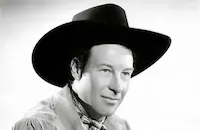Kansas Territory
Cast & Crew
Lewis Collins
Wild Bill Elliott
House Peters Jr.
Peggy Stewart
Lane Bradford
Stan Jolley
Film Details
Technical Specs

Synopsis
In 1874, Joe Daniels enters Redding, Kansas, where he is still considered a criminal for old war activities, to avenge the death of his brother Johnny. Joe is greeted at the state border by his old friend, Marshal Matt Furness, and Deputy Bob Jethro. Knowing Joe's purpose, Matt urges him to obtain a legal pardon, and warns him that he will have to jail him if he kills anyone. Dissatisfied with Joe's noncommittal answer, Bob pulls a gun, and Joe protects himself by shooting Bob in the shoulder. Hours later, Bob sends word to Redding that Joe escaped, and is ordered to kill him when he heads into town. After Joe is shot at, he flees to the nearest ranch, where he is rescued by Kay Collins. She brings Joe home, but when her wheelchair-bound father Sam discovers that Joe is Johnny's brother, he angrily kicks him out. Joe travels on to Redding and tries to rent a hotel room, but the hotelier, Weatherbee, turns him away when he hears Joe's last name. Confused as to why Johnny was so despised, Joe checks out the saloon that was co-owned by Johnny and A. Slater, who Joe believes is behind the attempts to kill him, and picks a fight with Bob's brother, Fred Jethro. Aided by lawyer Ralph Carruthers, Joe wins the fight but, without realizing it, drops the only copy of Johnny's will, which names him as the new co-owner of the saloon. Carruthers later informs Joe that Johnny became mixed up with Slater's gang and turned into a murderous criminal, killing Weatherbee's only son and alienating his fiancée, Kay. Johnny soon realizes he has lost the will, but Carruthers warns him that going back for it will only result in a gunfight, and promises to testify as to its contents. The next morning, Joe runs into Kay, who asks him to attend a council meeting at her ranch. Although she will not reveal why she never married Johnny, she tells him that Johnny was not as good a man as Joe. While they travel to the meeting, Bob arrives in Redding and informs Fred that Matt is arriving with a pardon for Joe. To thwart Joe, the brothers plan to kill the marshal. At the council meeting, the leaders of the community, impressed by Joe's courageous stand against Fred, ask him to act as sheriff, but he insists that he is only there to avenge Johnny's murder. One by one, the members detail how corrupt and cruel Johnny had become, but Joe refuses to believe them, and after he leaves they name Carruthers as sheriff. On the trail back to Redding, Joe witnesses Bob kill Matt and chases him, with the council close behind. While Kay picks up Bob's hat and finds Joe's pardon inside, the council watches Joe catch Bob, who confesses to Matt's murder. On the way back to town, Carruthers shoots Bob for trying to escape and then tells Joe that Bob, before dying, named Slater as Johnny's killer. Joe races to the saloon and challenges Slater to a gunfight. Kay, eager to stop the fight, shows Joe the pardon and informs him that Johnny hit her and then crippled Sam when he tried to intercede. When Slater adds that Johnny's gang almost ruined him, Joe finally realizes that his brother had become an outlaw. Just then, Fred learns that Carruthers killed Bob, and blurts out that Carruthers is the actual gang boss. Disgusted, Joe turns to leave, and Fred shoots Carruthers. Later, Slater asks Joe to help run the saloon, but Joe cedes his half interest to Sam and is rewarded with a kiss from Kay.

Director
Lewis Collins
Cast

Wild Bill Elliott
House Peters Jr.
Peggy Stewart
Lane Bradford
Stan Jolley

Fuzzy Knight
Stan Andrews
Marshall Reed
Terry Frost
John Hart
William Fawcett
Lee Roberts
Pierce Lyden
Ted Adams

Lyle Talbot
Crew
Mary Chaffee
Charles Cooper
Jack Dowsing
Vincent M. Fennelly
Richard Heermance
Raoul Kraushaar
Ernest Miller
David Milton
Stanley Price
Melville Shyer
Vincent Taylor
Dan Ullman

Film Details
Technical Specs

Quotes
Trivia
Notes
The working title for this film was Vengeance Trail. Although contemporary reviews state that Kansas Territory was shot in sepia, the viewed print was black and white.












